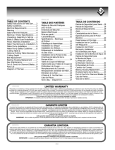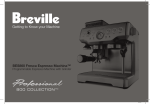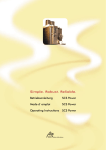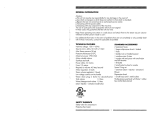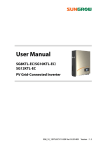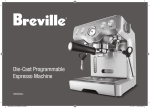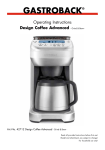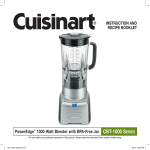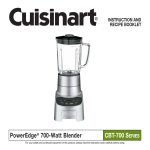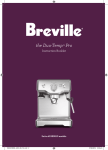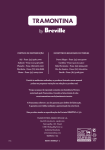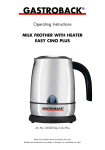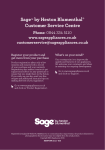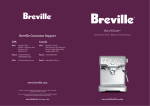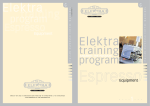Download Gastroback 42620 coffee maker
Transcript
Operating Instructions Design Espresso Advanced – BARISTA EDITION Art.-Nr. 42620 Design Espresso Advanced – Barista Edition Read all provided instructions before first usage! Model and attachments are subject to change! For household use only! Carefully read all provided instructions before you start running the appliance and pay attention to the warnings mentioned in these instructions. Table of Contents Knowing Your Design Espresso Advanced – Barista Edition...................................... 40 Important Safeguards.......................................................................................... 42 Important Safeguards for all Electrical Appliances.............................................. 45 High Temperatures—Risk of Burns.................................................................... 46 Technical Specifications...................................................................................... 46 Features of Your Design Espresso Advanced – Barista Edition................................... 47 Before first Use................................................................................................. 51 Assembling Your Design Espresso Advanced – Barista Edition.............................. 51 Using Your Design Design Espresso Advanced – Barista Edition................................ 52 Single Wall Filters for Aspiring Baristas............................................................ 53 The Art of Texturing Milk................................................................................. 58 Using Hot Water Outlet.................................................................................. 59 Espresso Making Tips..................................................................................... 60 Care and Cleaning............................................................................................ 62 Storage............................................................................................................. 66 Troubleshooting................................................................................................. 66 Notes for Disposal.............................................................................................. 68 Information and Service...................................................................................... 68 Warranty.......................................................................................................... 68 Recipe Ideas...................................................................................................... 69 Dear Customer! Congratulations! A series of new possibilities come with your new Gastroback Design Espresso Advanced – Barista Edition. With the integrated conical burr grinder you can extract a prefect espresso in uder one minute. At Gastroback, we know that espresso lovers will go to great lengths to refine the art of making espresso. They will experiment with flavors and adjust the grind of the beans and the tamp in search for the perfect espresso. With Gastroback Design Espresso Advanced – Barista Edition and its integrated coffee grinder, making that perfect fresh espresso has never been simpler. Why are freshly ground beans best? It’s all about the flavor. Once ground, coffee remains fresh for only a few short m nutes and is therefore best to grind just before extracting. With the Gastroback Design Espresso Advanced – Barista Edition you can be the barista and explore the art of espresso at home. These instructions for use will inform you about the various functions and features, which make it easy to take pleasure in your new Gastroback Design Espresso Advanced – Barista Edition. We hope that you will enjoy your new Gastroback Design Espresso Advanced – Barista Edition. Your Gastroback GmbH Knowing Your Design Espresso Advanced – BARISTA EDITION A H B C D i J E K F G L M N A.Automatic Dosing: Select between single or double filter basket. B. Mechanical Clutch Protection C.Grind Size Selector: 19 grind settings from fine to coarse. D.POWER Button: Surround illuminates when machine is switched on. E. Grind Amount Dial: Controls the amount of fresh ground coffee dosed into the filter basket. F. Integrated Removable Tamper: For consistent tamping control. G.Grinding Cradle: For directly dosing into portafilter. H. Cup Warming Tray I. CLEAN ME Light: Indicates when a cleaning cycle is required. J. S team Light /Hot Water: Illuminates to indicate that the steam or hot water function is selected. K. Group Head L. Extra-Tall Cup Height For Coffee Mugs M.Removable Wet And Dry Coffee Separator Drip Tray N.Drip Tray Full Indicator O.250g Bean Hopper Capacity P. Integrated Conical Burr Grinder: Stainless steel conical burrs maximise ground coffee surface area for full espresso flavour. Q.Pressure Gauge: Monitors espresso extraction pressure. R. PROGRAM Button: Personalise your espresso shot volumes & also accesses Advanced Temperature functions. 40 P Q R O S T U V W S. STEAM Dial /Hot Water Dial: Selector control for steam and hot water. T. Programmable 1 CUP and 2 CUP button. U.Instant Hot Water: Dedicated hot water outlet for making long blacks and pre-heating cups. V. Stainless Steel Portafilter: With commercial style spouts. W.360° Swivel Action Steam Wand: Easily adjusts to perfect position for texturing. Zubehör: •the Razor – Dose trimming tool • Single Wall Filters X 2 •Stainless Steel Frothing Jug with ›Latte Art‹ pouring spout • Cleaning Disc (holds tablets in place) • Integrated / Removable Tamper • Cleaning Tool • Cleaning Brush • Allen Key 41 Important Safeguards Carefully read all instructions before operating this appliance and save for further reference. Do not attempt to use this appliance for any other than the intended use described in these instructions. Any other use, especially misuse, can cause severe injuries or damage by electric shock, heat or fire. Any operation, repair and technical maintenance of the appliance or any part of it other than described in these instructions may only be performed at an authorised service centre. Please contact your vendor. • This appliance is for household use only and not intended for use in moving vehicles. Do not operate or store the appliance in humid or wet areas or outdoors. Any use of accessories, attachments or spare parts not recommended by the manufacturer may result in damage and/or injuries to persons. • Check the entire appliance regularly for proper operation—especially the power cord. Do not use the appliance if the non-stick coating is damaged in any way (e.g. scratched, or peeling off). Do not operate the appliance, when liquids are in the housing of the appliance or accumulate under the appliance or overflow. Do not operate the appliance, when the appliance or any part of it is likely to be damaged, to avoid risk of fire, electric shock or any other damage and/or injuries to persons. The appliance is likely to be damaged if the appliance was subject to inadmissible strain (e.g. overheating, mechanical or electric shock), or if there are any cracks, excessively frayed or melted parts, or distortions, or if the appliance is leaking or not working properly. In this case, immediately unplug the appliance and return the entire appliance (including all parts and accessories) to an authorised service centre for examination and repair. • Always ensure the appliance is properly assembled before connecting to power outlet and operating. Follow the instructions provided in this book. • During operation keep the appliance in an appropriate distance of at least 15 cm on each side and 1 m above to furniture, walls, boards, curtains, and other objects. Do not operate the appliance beneath or below any heat-sensitive or moisture-sensitive materials, boards, or drop-lights to avoid damage caused by steam, heat, or condensate. Operate the appliance on a well accessible, stable, level, dry, heat-resistant, water-resistant and suitable large table or counter. Do not place the appliance over a power cord, or near the edge of the table or counter, or on wet or inclined surfaces, or where it can fall. Always keep the appliance and the table or counter clean and dry, and wipe off spilled liquids immediately. • Do not place any clothes or tissue or other objects under or on the appliance during operation, to avoid risk of fire, electric shock and overheating. Before operation, always ensure that there are no foreign objects in or under the pot, and the appliance is assembled properly and not leaking with the lid and upper cover firmly in place. Solely use the appliance for processing edible food. Immediately unplug the appliance, if there is any kind of malfunction or problem (e.g. leaking, overheating). • This appliance is not intended for use by persons (including children) with reduced physical, sensory or mental capabilities, or lack of experience and knowledge, unless they have been given supervision or instruction concerning use of the appliance by a person responsible for their safety. Children must be supervised to ensure that they do not play with the appliance or any parts of the appliance or the packaging. Do not leave the appliance unattended, when it is in reach of young children. Always keep the appliance where it is dry and clean and where young children cannot reach it. Do not place any hard and/or heavy 42 objects on the appliance or any part of it. Take care that no one will pull the appliance by the power cord. • Remove and safely discard any packaging material and promotional labels or stickers before using Design Espresso Advanced – Barista Edition for the first time. • To eliminate a choking hazard for young children, remove and safely discard the protective cover fitted to the power plug of this appliance. • Do not place the appliance near the edge of a bench or table during operation. Ensure the surface is level, clean and free of water and other substances. Do not use the appliance on a sink drain board. Do not place the appliance on or near a hot gas or electric burner, or where it could touch a heated oven. • The appliance is not intended to be operated by means of an external timer or separate remote control system. • Do not use attachments other than those provided with the appliance. The use of accessory attachments not recommended by Gastroback may result in fire, electric shock or injury to persons. • Do not attempt to operate the appliance by any method other than those described in this book. • Do not operate the grinder without the hopper lid in position. Keep fingers, hands, hair, clothing and utensils away from the hopper during operation. Avoid contacting moving parts. • Use only cold, tap water in the water tank. Do no use any other liquid. • Never use the appliance without water in the water tank. • Ensure the portafilter is firmly inserted and secured into the brewing head before using the machine. • Never remove the portafilter during the brewing operation as the machine is under pressure. • Do not move the appliance whilst in operation. • Do not use abrasive cleaners or cleaning pads (e.g. metal scouring pads) for cleaning. Do not clean the appliance with any corrosive chemicals (e.g. bleach). Do not immerse the appliance or power cord in water or any other liquid. Do not spill or drip any liquids on the appliance or on the power cord to avoid risk of fire and electric shock. When liquids are spilled in the appliance, immediately switch off, unplug the power cord and wait for the appliance to cool down. Thereafter, clean and dry the appliance thoroughly (See: ›Care and Cleaning‹). • Do not leave the appliance unattended when in use. • Do not touch hot surfaces. Use handles or knobs. Allow the appliance to cool down before moving or cleaning any parts. • Do not place anything, other than cups for warming, on top of the the appliance. • Always switch off the appliance by pressing the POWER button to ›off‹ and unplug if appliance is to be left unattended, if not in use, before cleaning, before attempting to move the appliance, disassembling, assembling and when storing the appliance. 43 • Keep the appliance and accessories clean. Follow the cleaning instructions provided in this book. • The appliance is heated by built-in electric heating elements. The appliance or power cord may never touch hot surfaces. Do not place the appliance or any part of it on or near hot surfaces (e.g. burner, heater or oven). Do not use any part of the appliance (e.g. pot, steamer) with any other device. • The appliance is designed for brewing espresso and coffee. Therefore, some components, such as the group head, the portafilter and the steam wand become very hot during operation and hot water or steam escape. • Do not operate the appliance with a damaged cord or plug or after the appliance malfunctions, or has been damaged in any manner. Immediately cease use and contact an authorised service center for examination, repair or adjustment. • Do not apply any force during operation to prevent damage to the components. •DO NOT place the appliance or power cord in an automatic dishwasher. • Do not leave any food dry on the appliance. Always clean the appliance after each use to prevent a build up of baked-on foods (See: ›Care and Cleaning‹). Always keep the appliance and the accessories clean. • After you have filled the correct quantity of ground coffee into the porta filter, you should press the ground coffee as evenly as possible. To do this, use the integrated tamper. The ground coffee should not be pressed too hard. • Wipe carefully the rim of the porta filter of any spilled coffee. The rim should be completely clean so that the porta filter can seal at the brew head pressure-tight. For an optimal results the pressure gauges should be located in the central zone. • The moisture content of the coffee grounds in the porta filter, which is due to the special brewing technology of the machine, represents not a malfunction of the appliance. • Leave the lid during operation, always on the bean hopper. • Make sure that the porta filter is firmly inserted before use in the group head. Never remove the porta filter during operation. • Store packaging materiasl out of reach of children. • Do not operate with carbonated water, but only in soft water (up to 4 ° dH = German hardness). • This appliance is intended to be used in household and similar applications such as: – staff kitchen areas in shops, offices and other working environments; – farm houses; – by clients in hotels, motels and other residential type environments; – bed and breakfast type environments. 44 Important Safeguards for all Electrical Appliances The appliance is heated electrically. Place the appliance near a suitable wall power socket to connect the appliance directly to a protected mains power supply with protective conductor (earth/ground) connected properly. Ensure that the voltage rating of your mains power supply corresponds to the voltage requirements of the appliance (220 - 240 V, 50 Hz, AC, rated for at least 8 A). The installation of a residual current operated circuit breaker (r.c.c.b.) with a maximum rated residual operating current of 30 mA in the supplying electrical circuit is strongly recommended. If in doubt, contact your electrician for further information. In various foreign countries, the specifications for power supplies are subject to incompatible norms. Therefore it is possible that power supplies in foreign countries do not meet the requirements for safe operation of the appliance. Thus, before operating the appliance abroad, ensure that safe operation is possible. • Do not to use any extension cords or multisocket outlets. • Always handle the power cord with care. Always completely unwind the power cord before use. Do not place the appliance on a power cord. Power cords may never be knotted, twisted, pulled, strained or squeezed. Do not let the plug or power cord hang over the edge of the table or counter. The power cord may not touch hot surfaces. Ensure that no one will pull the appliance by the power cord. Take care not to entangle in the power cord. Always grasp the plug to disconnect the power cord. Do not touch the power plug with wet hands when the appliance is connected to the power supply. • Unwind the power cord fully before use. • To protect against electric shock do not immerse power cord, power plug or appliance in water or any other substance. • This appliance is not intended for use by persons (including children) with reduced physical, sensory or mental capabilities, or lack of experience or knowledge, unless they have been given supervision or instruction concerning use of the appliance by a person responsible for their safety. • Children should be supervised to ensure they do not play with the appliance. • The appliance has a short cord as a safety precaution to prevent personal injury or property damage resulting from pulling, tripping or becoming entangled with the cord. Do not allow children to be near or use this appliance without close adult supervision. If you must use a longer cord or an extension cord when using the appliance, the cord must include a 3-prong grounding plug. It must be arranged so it will not drape or hang over the edge of a countertop, tabletop or surface area where it can be pulled on by young children or tripped over. To prevent electric shock, personal injury or fire, the electrical rating of the extension cord you use must be the same or more than the wattage of the appliance (wattage is marked on the underside of the appliance). • This appliance is recommended for household use only. Do not use this appliance for anything other than its intended use. Do not use in moving vehicles or boats. Do not use outdoors. Misuse may cause injury. CAUTION: To ensure continued protection against risk of electric shock, connect to properly earthed outlets only. 45 High Temperatures – Risk of Burns • The Design Espresso Advanced – Barista Edition is designed for brewing espresso and coffee. Therefore, some components, such as the group head, the portafilter and the steam wand become very hot during operation and hot water or steam escape. • Do not touch during operation and shortly thereafter hot parts (eg. group head, porta filter, swivel steam wand with frothing attachment). Even after switching off the appliance and the corresponding parts are very hot for some time. • Hot steam may escape or hot water may drip from the group head and the swivel steam wand. Therefore always ensure that the swivel steam wand points towards the drip tray when not in use. Never hold your hands or other body parts or moisture and heat-sensitive items onto or below the porta filter, group head, swivel steam wand with frothing attachment when the appliance is turned on. • Always make sure that the porta filter inserted correctly into the group head before operating the appliance. When brewing the espresso high pressure is produced - risk of burns! • Never remove the porta filter during brewing. • Always wait until the appliance is cooled down to room temperature and empty the water tank and the drip tray before moving or cleaning the appliance. Grasp the appliance on both sides of the bottom of the appliance base (not the drip tray!) If you want to move the appliance. Technical Specifications Model: Art. No. 42620 Design Espresso Advanced – Barista Edition Power supply: 220 - 240 V, 50 Hz Power consumption: 1,700 W Length of power cord: ca. 112 cm Weight: ca. 10.4 kg Dimensions: ca. 310 x 300 x 365 mm (width x depth x height) Capacity of water tank: 2 Litre Capacity of bean hoper: 250 g for up to 30 shots of espresso Certification: 46 Features of Your Design Espresso Advanced – Barista Edition Integrated Conical Burr Grinder The integrated conical burr grinder allows each espresso produced from the appliance to be created using freshly ground beans - the key to achieving your ideal espresso. Preset or Adjustable Grind Size The GRIND SIZE dial accurately adjusts the fineness or coarseness of the espresso grind for optimal espresso extraction. For a fast and easy espresso, or novice espresso machine users, set the GRIND SIZE dial to DUAL WALL and use the included DUAL WALL FILTERS. Refer to ›Using Your Machine‹ on page 52. For more experienced espresso machine users, or those interested in perfecting their espresso making skills, use the included SINGLE WALL FILTERS. Refer to ›Using Your Machine‹ (Step 4 & 5) on page 54 for details on where to set this dial. Preset or Adjustable Grind Amount The GRIND AMOUNT dial accurately adjusts the quantity of beans that will be ground and dispensed into the filter, ready for extraction. This quantity should be adjusted according to the fineness or coarseness selected on the GRIND SIZE dial. For a fast and easy espresso, or novice espresso machine users, set the GRIND AMOUNT dial to DUAL WALL and use the included DUAL WALL FILTERS. Refer to ›Using Your Machine‹ on page 52. For more experienced espresso machine users, or those interested in perfecting their espresso making skills, use the included SINGLE WALL FILTERS. Refer to ›Using Your Machine‹ (Step 4 & 5) on page 54 for details on where to set this dial. Hands Free, Direct Grinding The appliance features an integrated grinding cradle located below the integrated conical burr grinder which fully supports the portafilter. The ‘hands free’ grinding feature allows you to continue with other preparations while the portafilter is being filled with the selected amount of freshly ground coffee beans. Place the portafilter into the cradle and simply push the portafilter toward the machine lightly to activate the grind function. 47 Integrated / Removable Tamper Tamping is the application of even and consistent pressure to the espresso grinds. The tamper is conveniently located ‘on board’ the machine and can be used both in the ‘on board’ position or whilst removed depending on your preference. Tamper an der Mahlstation Tamper frei verwendet Programmable Function The appliance offers a convenient choice between preset shot sizes (1oz or 2oz), manual function (over-rides preset shot size for one time only) or a programmable function that reprograms the preset shot sizes with the user’s preferred shot size. Espresso Ppressure Gauge The espresso pressure gauge assists in obtaining the most favorable extraction pressure, guiding the user to create their ideal espresso. This is achieved by measuring the pressure at which the water is being forced through the ground espresso in the portafilter. The ideal position of the gauge needle is anywhere within the ESPRESSO RANGE. 48 Note: While the Pressure Gauge is a great guide to the quality of the extraction, the best indicator is the look and taste of the espresso. Commercial Style Steam Wand The swivel-action steam wand easily adjusts to the perfect position for texturing milk. The wand has a commercial style 360° ball joint. Note for frothing milk: About half of the steam wand must be immersed in the milk. Note: If steam is already escaping from the steam wand and it is not immersed in the milk, the escaping steam can squirt milk out of the jug. Important: Make sure that the milk does not run over the edge of frothing jug. WARNING: Do not Take the steam wand out of the milk, as long as steam escapes. Otherwise hot milk may splash out of the frothing jug. Turn the steam dial always back to the starting position (OFF position) before you remove the frothing jug from the steam wand. About 5 seconds after turning off the steam function a short burst of steam from the steam wand occurs. Be careful not to scald yourself on the hot steam. Note: Hot steam may escape or hot water may drip from the group head and the swivel steam wand. Therefore always ensure that the swivel steam wand points towards the drip tray when not in use. Filter Size Adjust the FILTER SIZE button according to the filter size you select, and along with the GRIND AMOUNT dial, the correct quantity of ground beans will be dispensed into the filter, ready for extraction. Single Wall Filters Single Wall Filters for Aspiring Baristas Experiment with grind size, grind amount and tamp The applianceis supplied with two Single Wall Filters - 1 x single shot and 1 x double shot. These filters provide no additional slowing of the water flow rate, hence experimentation with the grind size, grind amount and tamp force is required to achieve favorable results. These 49 filters are suited to both pre-ground vacuum packed espresso as well as beans ground fresh in the integrated grinder. Refer to ›Using Your Machine‹ (Step 4 & 5) for details on where to set the GRIND SIZE and GRIND AMOUNT dials. The Single Wall Filters have no markings on the underside of the filter. Energy Saving Features The appliance will enter the ›Power Save Mode‹ if not used for one hour, and will automatically switch off if not used for a further three hours. The ›Power Save Mode‹ uses 50% less power than when the machine is in ›Stand By‹ Mode. During ›Power Save Mode‹ only the POWER button surround will flash slowly. All other button light surrounds will not be illuminated. To re-activate the machine during ›Power Save Mode‹ simply press any button except POWER. The POWER button surround will then illuminate and flash while the machine quickly reheats to operational temperature. When the correct temperature has been reached, all the button surrounds on the control panel will illuminate. To switch off the espresso machine whilst it is in ›Power Save Mode‹, simply press the POWER button once. The Razor - Dose Trimming Tool For precise dose control. Additional Features Electronic PID Temperature Control For increased temperature stability. Auto Purge Automatically adjusts water temperature after steam for optimal coffee extraction. Adjustable Temperature Control For optimum coffee flavour. Thermocoil Heating System Integrated stainless steel water coil accurately controls water temperature. Low Pressure Pre-infusion Gradually increases pressure at the start for an even extraction. Espresso Pressure Gauge Measures the water pressure through the ground coffee in the portafilter during extraction. Dry Puck Feature Releases water pressure from the ground coffee in the filter basket for easy disposal of the coffee puck. 1700W High Power For faster heat up and high pressure steam. Instant Hot Water Dedicated hot water outlet for making long blacks and pre-heating cups. 50 Before First Use The appliance has the drip tray, water tank and storage tray in place when you unpack it from the box. The drip tray is located in the base of the machine towards the front. The water tank is located in the back of the machine. The charcoal water filter is located inside the water tank. It needs to be removed before washing the water tank. The storage tray is located at the base of the machine behind the drip tray. The drip tray, water tank and storage tray slide in and out for easy access. The bean hopper is located on top of the drip tray when the machine is first unpacked. Ensure you have removed all parts and accessories before discarding the packaging. Remove the water tank and wash in warm, soapy water using a non-abrasive washing liquid. Rinse and dry thoroughly. Wipe the outer housing, bean hopper and drip tray with a soft damp cloth and dry thoroughly. Do not immerse the outer housing, power cord or power plug in water or any other liquid. Note: Do not clean any of the parts or accessories in the dishwasher. Assembling Your Design Espresso Advanced – Barista Edition 1.Insert the storage tray into the base of the machine and slide towards the back wall. The storage tray conveniently stores all the cleaning accessories and filters so they are not misplaced. 2.Insert the ›Empty Me!‹ indicator into the drip tray and place the Coffee Grinds Separator on top. Then place grill on top. Slide the drip tray into position in the base of the machine in front of the storage tray. 3.Before installing the charcoal water filter, remove it from the plastic bag, and soak in a cup of water for 5 minutes. Rinse the filter under cold running water for 5 seconds. Wash the stainless steel mesh in the plastic filter holder with water and assemble. Set the date dial to 2 months ahead. Insert the assembled filter holder into the empty water tank and push to lock into place. Note: Please refer to ›Care and Cleaning‹ on, ›Installing the Filter in the Water Tank‹ 4.Insert the Hopper into position and turn the hopper dial clockwise 90° to lock. Note: Refer to ›Care and Cleaning‹ instructions to properly maintain your burr grinder. Note: Before each use it is recommended to complete a water flushing operation, without ground espresso in the portafilter, to ensure that the machine has been preheated. 51 Using your Design Espresso Advanced – Barista Edition 52 Single Wall Filters for Aspiring Baristas Experiment with grind size, grind amount and tamp The appliance is supplied with two Single Wall Filters - 1 x single shot and 1 x double shot. These filters provide no additional slowing of the water flow rate, hence experimentation with the grind size, grind amount and tamp force is required to achieve favorable results. These filters are suited to both pre-ground vacuum packed espresso as well as beans ground fresh in the integrated grinder. A great espresso is a balance of main flavor elements: acidity, aroma, bitterness, body, nuttiness, and sharpness. By using the Single Wall Filters you are free to explore the world of espresso by adjusting grind, grind amount and tamp to extract a rich variety of flavors. STEP 1 – FILLING THE WATER TANK • Ensure the charcoal water filter is securely fitted inside the tank. Refer to ›Care and Cleaning‹, ›Installing the Filter in the Water Tank‹ • Fill the water tank with cold tap water to the maximum mark on the side of the tank and slide the water tank carefully back into position at the back of the machine. • Plug the power cord into a power outlet. • Press the POWER button to ›on‹, the POWER button surround will flash while the machine is heating. When the correct temperature has been reached, all the button surrounds on the control panel will illuminate. STEP 2 - PRE-WARMING THE CUPS This will help maintain the espresso’s optimal temperature when brewed into the cups. • The cup warming plate will start to warm as the machine heats. • Run hot water from the group head without the portafilter inserted by holding down the -button on the front, right hand side of the machine, then place the cups on the warming tray. Note: Check the water level before use and replace the water daily. The water tank should be refilled with fresh, cold tap water before each use. Do not use mineral or distilled water or any other liquid. STEP 3 – PREPARING THE SINGLE WALL FILTER • Place the single or double shot Single Wall Filter into the portafilter. When brewing into a larger mug, always use the double shot filter and only extract 2oz. If you require a larger serving, add the hot water first and then extract the espresso. • Preheat the portafilter by placing underneath the group head. Rinse with hot water from the group head by holding down the double shot button on the front, right hand side of the machine. Dry the portafilter thoroughly before use. Unlike the Dual Wall Filters, the Single Wall Filters have no markings on the underside of the filter. • Place the portafilter into the grinding cradle • Press the FILTER SIZE button according to the filter size (single shot or double shot) you select. 53 STEP 4 – ADJUSTING THE GRIND SIZE • When setting the grind size it should be fine but not too fine or powdery. The grind will effect the rate at which the water flows through the ground espresso in the filter and therefore the taste of the espresso. • If the grind is too fine (looks like powder and feels like flour when rubbed between fingers), the water will not flow through the ground espresso even when under pressure. The resulting espresso will be over extracted, too dark and bitter, with a mottled and uneven crema on top. • If the grind is too coarse the water will flow through the ground espresso too quickly. This will result in an under-extracted espresso lacking in flavor and without the thick crema on the top. STEP 5 – ADJUSTING THE GRIND AMOUNT • When grinding for a Single Wall Filter using a finer espresso grind, you will need to increase the grind amount to ensure the filter is correctly filled. • To increase the grind amount, turn the GRIND AMOUNT dial beyond the DUAL WALL setting to obtain the correct amount of ground espresso. Note: You may need to try step 4 and 5 a few times, slightly adjusting the GRIND SIZE and GRIND AMOUNT dials each time until you reach your desired combination. STEP 6 – GRINDING THE BEANS • Fill the hopper with fresh coffee beans. • Ensure the portafilter is inserted into the grinding cradle. • Ensure the FILTER SIZE button reflects the filter size inserted in the portafilter. • For Auto Start and Stop Grinding - push the portafilter in once to activate the grinding switch, then allow the portafilter to be filled with fresh ground espresso. Note: To stop the auto grinding midway through a grinding cycle, push the portafilter in once, or press the FILTER SIZE button. • For manual grinding - push and hold the portafilter in until the desired amount of ground espresso has been delivered. 54 STEP 7 - TAMPING THE GROUND ESPRESSO For ease of use, the appliance provides two handy ways to tamp your espresso: 1.Tamper on Board: The tamper device is held in place, on the machine, allowing for convenient tamping. a. Once the grind function has been completed, remove the portafilter from the grinding cradle. Gently level the grinds in the portafilter with your finger. b. With the tamper fitted into place, lift the portafilter towards the tamper base c. Push the portafilter upward firmly, applying even pressure to tamp the espresso d. Release the portafilter from the tamper, and clean any excess ground espresso from the rim of the portafilter to ensure a correct fit into the group head. Note: Tamping between measures will create a layer in the ground espresso that can impede full extraction. 2.Tamping Control: The tamper device is removable for hand tamping. Remove the tamper from the machine a. Once the grind function has been completed, remove the portafilter from the grinding cradle. Gently level the grinds in the portafilter with your finger. b. Use one hand to grip the tamper and the other hand to hold the portafilter handle c. Apply even pressure down on the tamper and press firmly in order to level and pack the espresso grounds d. Lift the tamper from the portafilter, and clean any excess grinds from the rim of the portafilter to ensure a correct fit into the group head. TRIMMING THE DOSE The Razor precision dose trimming tool allows you to trim the puck to the right level for a consistent extraction. Insert the Razor™ into the coffee basket until the shoulders of the tool rest on the rim of the filter basket. The blade of the dosing tool should penetrate the surface of the tamped coffee. Rotate the Razor dosing tool back and forth while holding the portafilter on an angle over the knock box to trim off excess coffee. Your coffee filter basket is now dosed with the correct amount of coffee. 55 STEP 8 - INSERTING THE PORTAFILTER Place the portafilter underneath the group head so that the handle is aligned with the insert graphic. Insert the portafilter up into the group head and rotate the handle to the right until resistance is felt, this will be at an approximate 90° angle to the machine. STEP 9 – EXTRACTING THE ESPRESSO • Ensure all the button surrounds on the control panel are illuminated, indicating the machine has reached the correct temperature for brewing, and is ready for use. • Ensure the drip tray and portafilter are in place. • Place one or two pre-warmed cups beneath the portafilter outlet. Note: PRE-BREW FUNCTION: When a preset shot size on the front, right hand side of the machine is selected, the machine will pump water momentarily, followed by a pause then continue to pump the water through to the grounds in the portafilter. The ground coffee is moistened by a small amount of water before full extraction. This expands the grinds, resulting in greater pressure build-up to extract all the oils and full flavor from the ground beans. PRESET SHOT SIZE - ONE SHOT -button once. A preset extraction of approximately 1 oz of espresso will be Press the delivered. A pumping noise will be heard in this operation. The machine will automatically stop once the preset pour has been delivered. Note: The amount of espresso extracted in the cup will vary depending on the coarseness of your grind and grind amount Note: When using a single shot filter, for optimal flavor, you should only extract approximately 1 oz. When using a double shot filter, for optimal flavor, you should only extract approximately 2 oz. PRESET SHOT SIZE - DOUBLE SHOT -button once. A preset extraction of approximately 2oz of espresso will be Press the delivered. A pumping noise will be heard in this operation. The machine will automatically stop once the preset pour has been delivered. Note: Pressing the the pour. -button or -button during an extraction will immediately stop PROGRAMMING SINGLE ESPRESSO Programming over-rides the preset shot sizes (1oz or 2oz), re-programming the button to pour your preferred shot size. 56 1.Prepare to make a single shot of espresso by following steps 2 to 6 in ›Dual Wall Filters for Beginners‹. 2.Place your cup underneath the group head. 3.To begin programming, press the PROGRAM-button once. The machine will beep once and the program button will begin to flash. This indicates the machine is in programming mode. 4.Press the -button once. The machine will commence normal pour function, and -button surround will begin to flash. -button to 5.When the desired amount of espresso has poured into the cup, press the stop the pour. The machine will beep twice, indicating it has saved your preferred pour quantity and exited programming mode. -button will now pour the saved shot size when pressed, unless reprogrammed, 6.The reset to the default settings, or overridden by the manual function. PROGRAMMING DOUBLE ESPRESSO Programming over-rides the preset shot sizes (1oz or 2oz), re-programming the button to pour your preferred shot size. 1.Prepare to make a two cup of espresso by following steps 2 to 6 in ›Dual Wall Filters for Beginners‹. 2.Place your cup underneath the group head. 3.To begin programming, press the PROGRAM-button once. The machine will beep once and the program button will begin to flash. This indicates the machine is in programming mode. -button once. The machine will commence normal pour function, and the 4.Press the -button surround will begin to flash. 5.When the desired amount of espresso has poured into the cup, press the -button to stop the pour. The machine will beep twice, indicating it has saved your preferred pour quantity and exited programming mode. 57 6.The -button will now pour the saved shot size when pressed, unless reprogrammed, reset to the default settings), or overridden by the manual function. RESETTING DEFAULT VOLUMES To reset the machine to the default one and two shot pour quantities, press and hold the PROGRAM-button until the machine beeps three times. Release button. This indicates the machine has returned to its original default settings. MANUAL FUNCTION The Manual function over-rides the preset shot size for one time only. It does not save the -button or -button. Release shot size like in programming mode. Press and hold the the button once sufficient espresso has flowed into the cup. STEP 10 – EMPTYING THE PORTAFILTER • Remove the portafilter from the group head by rotating the portafilter to the left until it releases. • To empty the used grounds, turn the portafilter upside down in a bin and gently knock out the grounds. Used grounds should be thrown away with domestic waste. Discarding of used grounds in a sink can cause drains to become blocked. • With the filter still in place, hold the portafilter underneath the group head, press and hold down the one cup button to release hot water. Rinse the portafilter until water runs clear. • Insert the portafilter back into the group head to dry out and keep warm. WARNING: THE METAL PARTS OF THE PORTAFILTER WILL BE VERY HOT. THE ART OF TEXTURING MILK The appliance comes complete with a commercial style swivel steam wand. • Fill the stainless steel frothing jug maximum ½ full with cold, fresh milk. • Turn the steam selector dial to the Steam-position. The red steam light will start to flash indicating that the machine is heating to create steam. • When the steam light stops flashing it is ready to use. • Before inserting the wand into the milk, pause the steam by returning the dial back to the STAND BY-position. This will avoid splashing the milk out of the jug (this pause function lasts for 6 seconds before exiting steam mode). • Insert the wand into the milk and return the Steam dial back to Steam-position. • To stop, return the steam dial to the STAND BY-position and remove the jug. Note: When the espresso machine creates steam, a pumping noise can be heard. This is the normal operation of the 15 Bar pump. Note: After 5 minutes of continuous steaming, the machine will automatically disable the steam function. The steam light will flash. When this occurs return the steam dial to the STAND BY-position. 58 WARNING: Milk should not be allowed torun over the top of the frothing attachment, otherwise it will not function properly. To avoid splattering of hot milk, do not lift the end of the frothing attachment above the surface of the milk while frothing. Ensure the steam selector dia is in the STAND BY-position before removing the frothing jug. There are two phases to texture milk: Stretching the milk to aerate it and swirling the milk to make it silky smooth and the right temperature. In practice these two operations should blend into one. STEP 1 - STRETCHING THE MILK Hold the jug so the tip of the steam wand is just below the surface of the milk and with your free hand engage the steam. Every so often lower the jug so the steam wand just breaks the surface of the milk and makes a hissing sound. Stretching the milk will increase the volume, so lower the jug as the milk rises to ensure the tip remains just above the surface of the milk. STEP 2 - SWIRLING THE MILK After a short while you will have aerated sufficiently. At this point, adjust the jug so the steam wand is off-center and create a spinning motion in the milk. Compensate for the angle of the steam wand by slightly tilting the jug away from you, or to one side and at the same time lower the nozzle further into the body of the milk. Continue swirling until milk is at desired temperature. Without a thermometer you’ll know the milk is ready when the jug base is ›just too hot‹ to touch. When you get the balance right the milk should end up forming a ›meringue-like‹ consistency that has a glassy sheen to it. Remove any excess air bubbles by gently knocking the jug against a hard flat surface and pour the milk down the inside of your chosen cup or glass to make your desired espresso variation. Lastly, run the steam function briefly to remove any residual milk in the steam wand tip. Then give the steam wand a good wipe with a damp cloth. Note: If stretching makes a loud screeching sound, this may inidicate that you have lowered the wand into the milk too early. Note: Always ensure that the frothing attachment has been firmly pushed onto the steam wand and connects with the rubber surround. For best results use cold fresh milk. Always clean the steam wand and frothing attachment after every use. Refer to ›Care and Cleaning‹. Note: For extracting more espresso immediately after using the steam function, this machine features an auto-purge function. This ensures the ground espresso coffee will not be burnt by the initial water flow from the thermocoil being too hot. Instead this water is automatically released internally into the drip tray ensuring that the internal thermostat is at optimal temperature for extracting espresso. Your espresso will always be extracted at this optimal temperature ensuring only the best flavored espresso is achieved. USING HOT WATER OUTLET Turn the STEAM/HOT WATER selector dial to the hot water position. The white steam light will flash to indicate the machine is heating to create hot water. When the steam light stops flashing, the hot water is up to temperature. To stop the flow of hot water, return the steam dial back to the STANDBY position. 59 ESPRESSO MAKING TIPS 60 WARMING YOUR CUP OR GLASS A warm cup will help maintain the espresso optimal temperature. Preheat your cup by holding down the one cup button and running hot water into the cups from the group head without the portafilter inserted and place the cups on the warming tray. WARMING THE PORTAFILTER A cold portafilter can drop the extraction temperature enough to significantly affect the quality of your espresso. Always ensure the portafilter is preheated by running hot water through it before preparing the espresso. Note: Always wipe the filter and portafilter dry before preparing the espresso as moisture can encourage drilling - this is when water bypasses the ground espresso coffee during extraction. USING PRE-GROUND ESPRESSO If using a pre-ground espresso, ensure an espresso grind suitable for espresso / cappuccino machines is purchased. THE RIGHT MEASUREMENT It is important to use the correct filter for the amount of espresso. A single espresso is made with 8 g of ground espresso. A level measure of the coffee scoop is the correct amount of coffee for a single espresso and 2 level measures for a double espresso. TAMPING CORRECTLY Level the desired amount of ground espresso by gently tapping the side of the filter holder before pressing down firmly with the tamper. When packing for a double espresso it is important only to tamp after the second measure. Tamping between measures will create a layer in the ground espresso that can impede full extraction. Note: Make sure to wipe off any excess ground espresso from the rim of the filter to ensure a proper seal is achieved under the group head. PURGE THE GROUP HEAD Before inserting the portafilter, run some water through the group head. It will ensure that your machine has a last minute ‘clean through’ and stabilizes the temperature prior to extracting. BREWING YOUR ESPRESSO The most common mistake in brewing is to over extract from your ground espresso. This results in a bitter beverage with visibly bleached crema. Crema is the caramel colored layer that floats on top of the espresso following extraction. Note: The taste of your espresso will, of course, depend on personal preference and on many other factors such as the type of coffee bean used, the coarseness or fineness of the grind and the tamping pressure. We recommend experimenting by varying these factors to achieve the espresso taste of your preference. Note: Always properly clean your machine after each use. 61 Care & Cleaning INSTALLING / REPLACING THE FILTER IN THE WATER TANK The Water Filter provided with the appliance can significantly reduce substances that affect the smell and taste of water such as free chlorine, certain pesticides and organic impurities as well as traces of heavy metals. The Water Filter can be removed from the water tank during operation if not required. • Remove the charcoal water filter from the plastic bag, and soak in a cup of water for 5 minutes • Rinse the filter under cold running water for 5 seconds • Wash the stainless steel mesh in the plastic filter holder with water and assemble • Set the date dial to 2 months ahead • To install, push down to lock into place Make sure to use Gastroback Waterfilters 97765. PORTAFILTER CLEANING Periodically run water through the machine with the portafilter in place, but without any ground espresso in the filter, to rinse out any residual coffee particles. 62 CLEANING CYCLE The appliance features an inbuilt cleaning cycle which should be carried out periodically. The CLEAN ME light will automatically illuminate to indicate to the user when a cleaning cycle is required. Make sure to use Gastroback Cleaning Tablets 97830. CLEANING CYCLE PROCESS GUIDE 1 Use a cleaning tablet. 2.Insert the cleaning disc into the single or double shot filter. 3.Place the filter into the portafilter. 4. Pop 1 cleaning tablet into the filter. 5.Lock the portafilter into the group head. 6.Turn the machine off. 7.Simultaneously press and hold the one cup, two cup and the POWER button for 3 seconds. 8.The cleaning cycle will commence and last for approximately 5 minutes. Once complete, 3 beeps will sound. Remove the portafilter and ensure the tablet has completely dissolved. If the tablet has not dissolved, repeat steps 5 to 7 until tablet has dissolved. Then rinse the filter and portafilter. DECALCIFYING After regular use, hard water can cause mineral build up in and on many of the inner functioning components, reducing the brewing flow, power of the machine, and affecting the quality of espresso. We advise decalcifying the machine on a regular basis using a mixture of citric acid and water or a liquid discaler. Follow the instructions provided, or use the following as a guide: 63 WARNING: Do not immerse power cord, power plug or aplliancein water or any other liquid. Tthe water tank should never be removed or completely emptied during decalcifying. DECALCIFYING THE MACHINE • Remove the portafilter and frothing attachment. Pour the mixture of white vinegar and water into the water tank. • Plug the machine into the power outlet. • Press the POWER button to the on-position. • Place a large container under the group head and steam wand. • When the brewing temperature has been reached all the button surrounds on the control panel will illuminate. Press and hold the one cup or two cup button to commence manual pour. Release the button once half the mixture of white vinegar and water has run through the group head. • Set the steam dial to the STEAM-position and allow steam to run through the steam wand for approximately 2 minutes. Return the steam dial back to the off-position. • After decalcifying, remove the water tank and rinse thoroughly then refill with fresh cold water. To rinse the machine, repeat previous steps. CLEANING THE CONICAL BURR GRINDER This grinder cleaning cycle removes oil build-up on burr heads which can impede performance. CLEANING THE STEAM WAND AND FROTHING ATTACHMENT • The steam wand and frothing attachment should always be cleaned after frothing milk. • Remove the frothing attachment and rinse in warm tap water. • Wipe the steam wand with a damp cloth, and then with the steam wand directed back into the drip tray, briefly set the steam dial to the STEAM-position. This will clear any remaining milk from inside the steam wand. 64 • Ensure the steam dial is in the STAND BY-position. Press the POWER button to off and allow the machine to cool. • If the steam wand remains blocked, use the pin on the cleaning tool to clear the opening. • If the steam wand continues to be blocked, the tip of the steam wand can be removed by using the fitting in the middle of the cleaning tool. • Unscrew the tip with the cleaning tool. • Soak the tip in hot water before using the pin on the cleaning tool to unblock. Replace the tip back onto the steam wand and secure with the cleaning tool. CLEANING / UNBLOCKING THE FILTERS, PORTAFILTER AND GROUP HEAD Periodically run water through the machine with the portafilter in place, but without any ground espresso in the filter, to rinse out any residual coffee particles. Should the fine holes in the filters become blocked follow the following steps: 1.Place the filter into the portafilter. Run water through the machine with the filter and portafilter, without any ground espresso, in place. 2.The fine pin on the cleaning tool can be used to clear any grinds in the filter holes. 3.To clean the single wall filters simply run water through the portafilter using the manual pour function by holding down the one cup button. 4.For a thorough clean of the filters, run a cleaning cycle of the machine with the portafilter and filter in place. Note: Pin on Cleaning Tool is extremely sharp. Use care when using. CLEANING THE OUTER HOUSING / CUP WARMING PLATE The outer housing and cup warming plate can be cleaned with a soft, damp cloth. Then polish with a soft, dry cloth. Do not use abrasive cleansers, pads or cloths which can scratch the surface. 65 CLEANING THE DRIP TRAY The drip tray should be removed, emptied and cleaned at regular intervals, particularly when the drip tray full indicator is showing ›Empty Me!‹. Remove grid, compartments and ›Empty Me!‹ indicator from the drip tray. Dispose of the grounds from the dry compartment into the waste bin. Wash the drip tray with warm soapy water, using a non-abrasive washing liquid, rinse and dry thoroughly. The ›Empty Me!‹ indicator can be removed from the drip tray by pulling upwards to release the side latches. The drip tray base and cover are dishwasher safe. CLEANING THE STORAGE TRAY The storage tray can be removed after the drip tray is removed then cleaned with a soft, damp cloth (do not use abrasive cleansers, pads or cloths which can scratch the surface). STORage Before storing, press the POWER-button to off, turn the steam dial to off and unplug. Remove unused beans from the hopper, empty the water tank and the drip tray. Ensure the machine is cool, clean and dry. Insert all accessories into position or into the storage tray. Store upright. Do not place anything on top. WARNING: Do not immerse power cord, power plug or aplliancein water or any other liquid. Tthe water tank should never be removed or completely emptied during decalcifying. TROUBLE SHOOTING GUIDE PROBLEM When the machine is switched on, the steam and hot water lights are flashing. Espresso does not run through. Espresso runs out too quickly POSSIBLE CAUSES Steam dial is not in STAND BY-position Machine is not turned on or plugged in WHAT TO DO Turn the Steam dial to STAND BY-position. Machine will commence normal heat up procedure. Ensure the machine is plugged in and the POWER button is pressed to on. Water tank is empty Refer to ›Filling The Water Tank‹, page 53. Espresso grind is too fine Ensure you use a suitable espresso grind. Refer to ›Adjusting the Grind Size‹ on page 54. Too much ground espresso in the filter Refer to ›Adjusting the Grind Amount‹, page54. Espresso grind tamped too firmly Refer to ›Tamping The Ground Espresso‹, page 55. The filter is blocked Clean the filters. Refer to ›Cleaning The Filters‹, page 65. The espresso grind is too coarse Ensure you use a suitable espresso grind. Refer to ›Adjusting the Grind Size‹ on page 54. Not enough ground espresso in the filter Refer to ›Adjusting the Grind Amount‹, page54. Ground espresso not tamped firmly enough Refer to ›Tamping The Ground Espresso‹, page 55. 66 PROBLEM Espresso is too cold POSSIBLE CAUSES Cups not preheated Milk not heated enough (if making a cappuccino or latté) No crema Espresso is not tamped firmly enough Espresso grind is too coarse Ground espresso is not fresh Filter holes are blocked Machine is making pulsing/ pumping sound while extracting espresso or steaming milk Espresso runs out around the edge of the filter holder Espresso extracts as drops from the portafilter Machine is making a loud and continuous pumping noise No steam is generated The machine is carrying out the normal operation of the 15 bar pump Filter holder is not inserted in the group head properly There are espresso grounds around the filter rim Too much ground espresso in the filter Ground espresso has been tamped too firmly Incorrect filter for amount of ground coffee used The water tank is empty or low Espresso grind is too fine Machine is blocked by mineral deposits Water tank is empty Water tank is not securely in place Machine is not turned on Water tank is empty Steam Dial is not in ‘Steam’ position Steam Wand is blocked Milk is not foamy after texturing Not enough steam Milk is not fresh and cold 67 WHAT TO DO Preheat cups. Refer to ›Pre-Warming The Cups‹, page 53. When the base of the jug becomes too hot to touch this is when the milk is heated at the correct temperature. Refer to ›The Art of Texturing Milk‹, page 58. Refer to ›Tamping The Ground Espresso‹, page 55. Ensure you use a suitable espresso grin Change old beans with fresh roasted or pre-ground. Ground espresso should not be kept for longer than a week. Use the fine pin on the cleaning tool to clear the holes. Refer to ›Cleaning The Filters‹, page 65. No action require as this is the normal operation of the machine. Refer to ›Inserting The Portafilter‹, page 55. Clean any excess ground espresso from the rim of the filter holder to ensure a proper fit into the brew head. Refer to ›Adjusting the Grind Amount‹, page54. Refer to ›Tamping The Ground Espresso‹, page 55. Ensure you use the small filter for 1 cup of espresso and the larger filter for 2 cups of espresso. Refer to step 1 – ›Filling The Water Tank‹, page 53. Ensure you use a suitable espresso grind. Refer to ›Adjusting the Grind Size‹ on page 54. Decalcify the machine. Refer to ⁄Decalcifying‹, page 63. Refer to step 1 – ›Filling The Water Tank‹, page 53. Refer to step 1 – ›Filling The Water Tank‹, page 53. Ensure the machine is plugged in, switched on at the power outlet and the POWER button is pressed to on. Refer to step 1 – ›Filling The Water Tank‹, page 53. Turn the steam dial to the Steam-position. Use the pin on the cleaning tool to clear the opening. If the steam wand continues to be blocked remove the tip of the steam wand using the fitting in the middle of the cleaning tool. Refer to ›Care and Cleaning‹, page 62. Steam wand may be blocked. Refer to ›Care and Cleaning‹, page 62. Use cold fresh milk. Refer to ‘›The Art of Texturing Milk‹, page 58. PROBLEM Machine is not working POSSIBLE CAUSES WHAT TO DO The unit appears to be on but the machine The safety thermal-cut may have activated due to the ceases to operate. pump or grinder overheating. Turn the machine off and allow it to cool for about 30 - 60 minutes. No ground espresso coming from No espresso beans in hopper. Fill hopper. grinder Grinder does not start when Bean Hopper safety interlock is open Remove hopper, check for any then debris replace micro switch is pressed. ‘Filter (hopper is not correctly in place). the hopper into the correct location. Size’ lights are cycling through single and double. Too much/too little ground Grind Amount settings are incorrect for Reset the machine to defaults or re-program new espresso Grind Amount settings. espresso is being delivered to the particular grind size. filter basket Notes for disposal Dispose of the appliance and packaging must be effected in accordance with the corresponding local regulations and requirements for electrical appliances and packaging. Please contact your local disposal company. Do not dispose of electrical appliances as unsorted municipal waste, use separate collection facilities. Contact your local government for information regarding the collection systems available. If electrical appliances are disposed of in landfills or dumps, hazardous substances can leak into the groundwater and get into the food chain, damaging your health and well-being. When replacing old appliances with new ones, the retailer is legally obligated to take back your old appliance for disposal at least for free of charge. Information and service Please check www.gastroback.de for further information. For technical support, please contact Gastroback Customer Care Center by phone: +49 (0)4165/22 25-0 or e-mail: [email protected]. Warranty We guarantee that all our products are free of defects at the time of purchase. Any demonstrable manufacturing or material defects will be to the exclusion of any further claim and within warranty limits of the law free of charge repaired or substituted. There is no warranty claim of the purchaser if the damage or defect of the appliance is caused by inappropriate treatment, over loading or installation mistakes. The warranty claim expires if there is any technical interference of a third party without an written agreement. The purchaser has to present the sales slip in assertion-of-claim and has to bear all charges of costs and risk of the transport. 68 Coffee-Recepies Espresso Cappuccino Intense and aromatic, an espresso or short black as it’s also known uses about ¼ oz of ground espresso. It is served in a small cup or glass to a level of approximately 1 oz. The real thing is served very light and luke warm with 1/3 espresso to 1/3 steamed milk and a generous final 1 /3 of creamy froth. For added finesse, hold a piece of card over one half of the cappuccino before dusting with chocolate. Americano Macchiato A long black is generally a single or double shot of espresso with hot water added to taste. A shot of espresso served short in a 2½ oz demitasse and stained with a dash of finely textured milk. Flat White A single shot of espresso in a cup filled with steamed milk and topped with a skin of silky smooth foam. Café Mocha A glass of textured milk laced with melted cocoa or chocolate syrup and an espresso shot. Top sprinkled with dark chocolate shavings. Classic Café Latté Traditionally the morning coffee of Italy and France, taken with pain au chocolate or sweet biscotti. This blend of 1/3 espresso to 2/3 milk is made with a single shot of espresso. Top with steamed milk, poured down the inside rim of the glass to give a creamy consistency and perfect layer of froth. Espresso Affogato Totally irresistible, this sweet temptation is simply a single scoop of premium vanilla bean ice cream, drenched in espresso and if desired, your favorite liqueur. To create a sense of occasion, serve ice cream in a martini glass with shots on the side. 69 Con Panna Tiramisu Meaning ›with cream‹ this heart warmer is a chic variation on old-fashioned Vienna Coffee. In a 3-4 oz cup, dress a double shot of espresso with a dollop of fresh cream, whipped until lossy. Dust with cinnamon and serve immediately. Makes 4 1½cups mascarpone 1¼cups cream 2½tablespoons powdered sugar ½ cup strong espresso coffee, cooled ½ cup coffee liqueur 16sponge fingers Cocoa powder, for dusting 1.Combine mascarpone, cream and powdered sugar in a large bowl. Whisk lightly until soft peaks form. Set aside. Baked Custards with Fresh Raspberry and Coffee Float 2.Combine espresso coffee and liqueur in bowl. Dip the sponge fingers into the espresso coffee mixture a few at a time. Ensure all the espresso coffee mixture is absorbed evenly by the sponge fingers. Serves 6 25 oz (750ml) cream ¾ cup finely granulated sugar 2 vanilla beans, cut lengthways 1 tablespoon gelatine 1 basket of fresh raspberries 1 tablespoon finely granulated sugar, extra ¾ cup strong espresso coffee, cooled 3.Layer half the sponge fingers evenly into the base of 4 dessert bowls or glasses. Spread the layered sponge fingers with half of the cream mixture. Repeat the layers with remaining sponge fingers and cream mixture. 1. Combine the cream, finely granulated sugar and vanilla beans in a saucepan. Stir over medium heat until just boiling. Remove the vanilla beans. 4.Dust evenly with cocoa powder and refrigerate until required. 2.Add the gelatine and stir constantly with a wooden spoon until dissolved. Remove from heat. Allow the custard to cool. 5.Serve with fresh fruits and freshly brewed espresso. 3.Pour custard evenly into 5 oz glasses. Refrigerate for a minimum of 3 hours or until set. 4.Place the raspberries into a medium sized bowl, sprinkle with sugar and crush lightly with a fork. 5.Fold the cooled espresso coffee through the crushed raspberries. Cover and chill in the refrigerator. 6.To serve, top the custards, when set, with the raspberries and espresso coffee mixture. 7. Serve immediately with freshly brewed espresso coffee. 70 Coffee, Cinnamon and Walnut Muffins Rich Eespresso Icing Makes 12 2½cups (375 g) plain flour 2 teaspoons baking powder 1 teaspoon ground cinnamon ¾ cup finely granulated sugar 1 cup sour cream 2 x 60 g eggs 1 teaspoon finely grated lemon rind 1 /3 cup olive oil ¾ cup strong espresso coffee, cooled 1 cup roughly chopped walnuts 2 cups powdered sugar, sifted 1 tablespoon butter, softened ¼ cup strong espresso coffee, warm 1.Combine powdered sugar, butter and half the espresso in a bowl, stir well and gradually add remaining espresso until a spreadable consistency is achieved. 1.Sift flour, baking powder and cinnamon into a large bowl and stir in sugar. 2.Place sour cream, eggs, lemon rind, oil and espresso coffee into a medium bowl, stir until well combined. 3.Fold creamed mixture and walnuts into the sifted ingredients, do not over mix. 4.Spoon the mixture evenly into 12 lightly greased and base lined muffin pans until two-thirds full. 5.Place into a preheated oven 350°F for 12-15 minutes or until cooked when tested. 6.Serve warm, or cooled and spread with Rich espresso Icing. Delicious with a Cappuccino or Café Latté. 71 GASTROBACK GmbH 20130909 Gewerbestraße 20 . 21279 Hollenstedt / Germany Telefon +49 (0)41 65/22 25-0 . Telefax +49 (0)41 65/22 25-29 [email protected] . www.gastroback.de




































